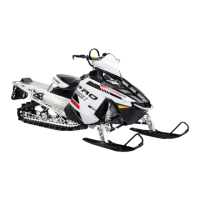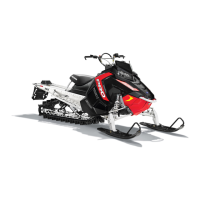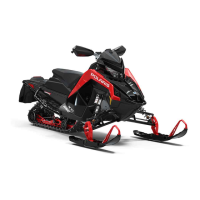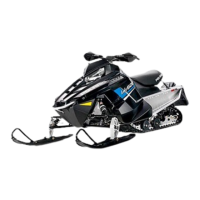8.70
Steering and Suspensions
PRO-RIDE PROGRESSIVE
SUSPENSION OPERATION
Operation
The Pro-Ride progressive suspension allows the rider to
easily adjust the desired amount of weight transfer, ski
pressure, and ride comfort using the following
components:
• Rear track shock spring preload
• Rear track shock compression dampener
• Front track shock spring preload
• Front track shock com
pression dampener
• IFS shock compression dampeners
• IFS shock spring preload
Unlike other Polaris rear suspensions, the Pro-Ride
pr
ogressive rear suspension is not coupled and does not
feature front or rear-rear scissor stops. The front torque
arm is not linked with the rear crank or rear scissor.
Weight transfer during acceleration is controlled by two
p
rimary factors. The first weight transfer control is the rear
track shock spring preload. The second weight transfer
control is rider position.
• Increasing rear track shock spring preload reduces
we
ight transfer during acceleration and increases
ski pressure in all driving modes
• Sitting or standing close to the fuel tank decreases
we
ight transfer and increases ski pressure in all
driving modes
• Decreasing rear track shock spring preload
incre
ases weight transfer during acceleration and
decreases ski pressure in all driving modes
• Sitting or standing at the rear of the seat increases
we
ight transfer under acceleration and decreases
ski pressure in all driving modes
Ride comfort is controlled by the compression dampener
a
djusters on the IFS, and front/rear track shocks. All
shocks offer sixteen compression dampening settings.
• Increasing shock dampenin
g reduces bottoming,
but makes the ride stiffer
• Decreasing shock dampening makes the ride
so
fter, but increases the chance the suspension
will bottom-out
Adjustment Procedures
Always adjust the Pro-Ride Progressive suspension
following these three steps:
1. Set the rear track shock spring preload for the rider
we
ight in everyday “street clothes”, not riding gear.
2. Adjust “fine tune” the balance of the snowmobile
based
on rider preference by increasing or decreasing
the rear track spring preload.
3. Adjust the shock compression dampeners to tune ride
qualit
y. Increase the compression dampening to
stiffen the ride. Decrease the compression
dampening to soften the ride.
STEP 1 - REAR TRACK SHOCK SPRING PRELOAD
1. The rear track shock spring preload is set to the
r
ider’s weight in everyday clothing, not riding gear.
2. Using the spring gauge tool supplied with the vehicle,
se
t the spring preload.
NOTE: Lifting up on the seat support will remove the
loa
d on the shock spring, making spring adjustment
easier.
3. If the shock threads are dirty or the preload knob is
diff
icult to turn, spray the threads with Shock Thread
Spray Lubricant, PN 2878018.
4. Place the spring gauge tool on top of the shock with
th
e narrow end against the spring retainer knob.
5. Reference where the silver shock body meets the red
sh
ock end cap. Turn the spring preload adjuster knob
in or out until the weight call out on the gauge is
aligned with the silver-meets-red parting line.
6. A tape measure can be used to set the spring preload
wh
en a gauge is not available, or an accessory rear
track shock spring is installed in place of the standard
spring.
7. Reference the Spring Guide Table when using a tape
m
easure for all springs.

